Drone-Borne LiDAR and Photogrammetry Together with Historical Data for Studying a Paleo-Landslide Reactivated by Road-Cutting and Barrier Construction outside Jerusalem
Abstract
1. Introduction
Background
2. Meteorological, Geological, and Geotechnical Background
2.1. The Natural Environment
2.2. Crevasses and Gravity Sliding
3. Methods
3.1. Historical Data
3.2. Recent Technologies
4. Results
4.1. Photogrammetry and Historical Data Comparison
4.2. LiDAR and Photogrammetry Comparison
4.3. Historical Data: Aerial Photos, Topographic Maps, Rain History, and Local Earthquakes
5. Discussion
5.1. LiDAR and Photogrammetry 2021/2022
5.2. Future Work
6. Conclusions
Author Contributions
Funding
Data Availability Statement
Acknowledgments
Conflicts of Interest
Appendix A
Appendix A.1. Natural Triggering of Landsliding and a Rockfall: Storms and Earthquakes
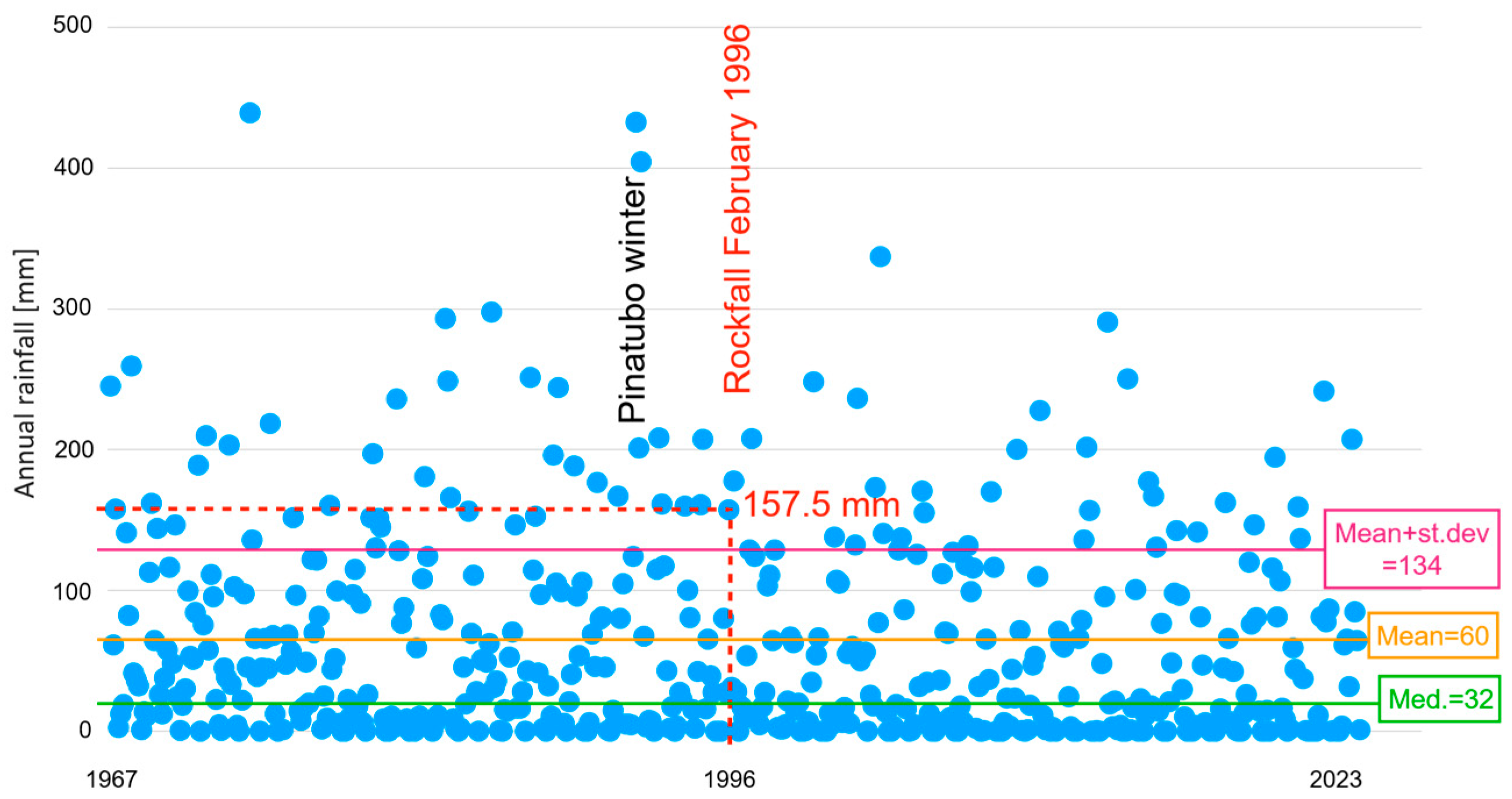

Appendix A.2. Earthquakes
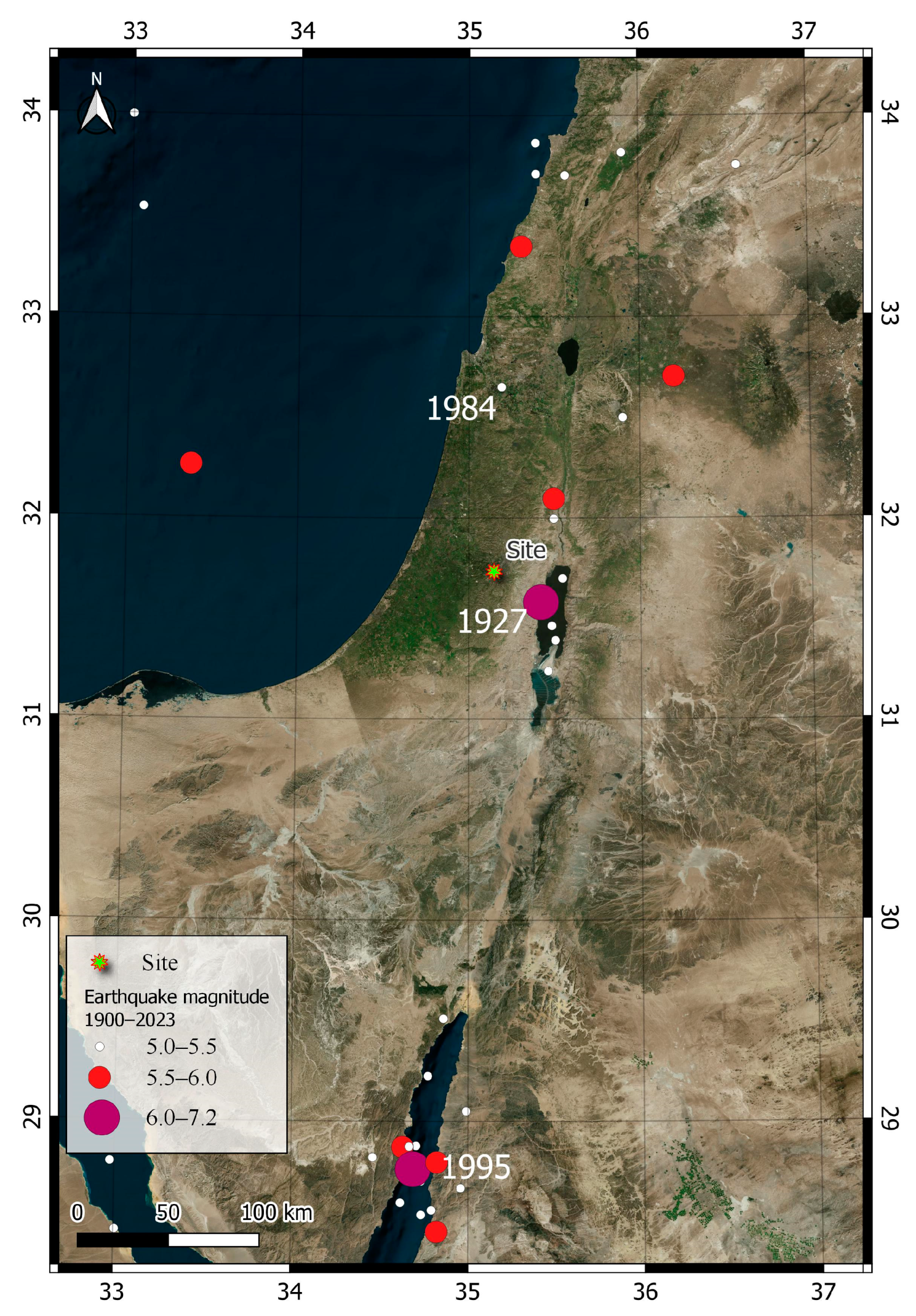

Appendix B. Cultural Values Damaged by Landsliding
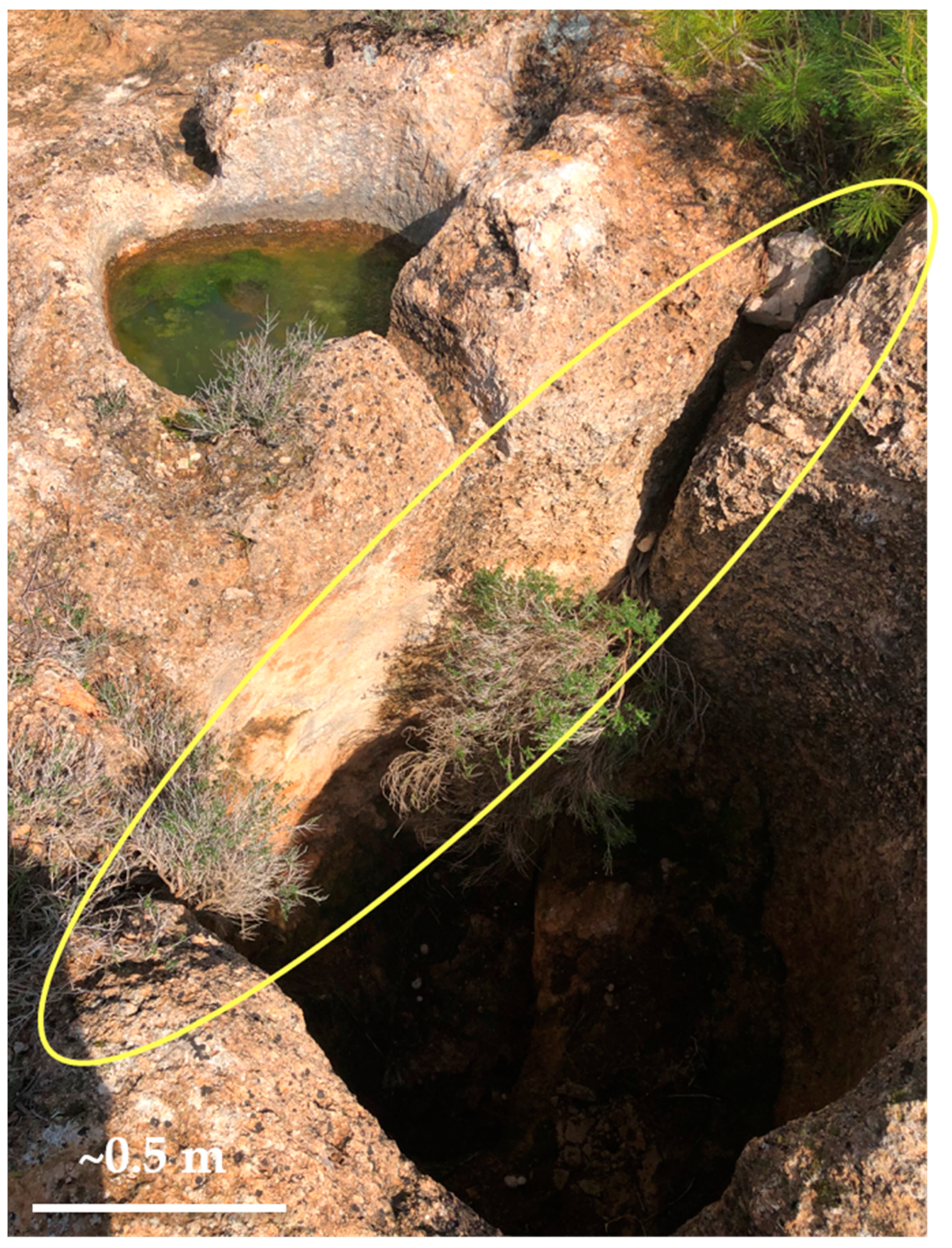
Appendix C

References
- Katz, O.; Reichenbach, P.; Guzzetti, F. Rock fall hazard along the railway corridor to Jerusalem, Israel, in the Soreq and Refaim valleys. Nat. Hazards 2011, 56, 649–665. [Google Scholar] [CrossRef]
- Ryb, U.; Matmon, A.; Porat, N.; Katz, O. From mass-wasting to slope stabilization–putting constrains on a tectonically induced transition in slope erosion mode: A case study in the Judea Hills, Israel. Earth Surf. Process. Landf. 2013, 38, 551–560. [Google Scholar] [CrossRef]
- Morin, E.; Ryb, T.; Gavrieli, I.; Enzel, Y. Mean, variance, and trends of Levant precipitation over the past 4500 years from reconstructed Dead Sea levels and stochastic modeling. Quat. Res. 2019, 91, 751–767. [Google Scholar] [CrossRef]
- Sneh, A.; Avni, Y. Geological maps of Israel (1:50,000) Sheet 11-II: Jerusalem - Sneh Amihai, Avni Yoav, 2011 (Partly revised, 2013). 2011. [Google Scholar]
- Hall, J.K. The 25-m DTM (digital terrain model) of Israel. Isr. J. Earth Sci. 2008, 57, 145–147. [Google Scholar] [CrossRef]
- Gadot, Y.; Davidovich, U.; Avni, G.; Avni, Y.; Piasetzky, M.; Faershtein, G.; Golan, D.; Porat, N. The formation of a Mediterranean terraced landscape: Mount Eitan, Judean Highlands, Israel. J. Archaeol. Sci. Rep. 2016, 6, 397–417. [Google Scholar] [CrossRef]
- Hough, S.E.; Avni, R. The 1170 and 1202 CE Dead Sea Rift earthquakes and long-term magnitude distribution of the Dead Sea Fault Zone. Isr. J. Earth Sci. 2011, 58, 295–308. [Google Scholar] [CrossRef]
- Agnon, A. Pre-instrumental earthquakes along the Dead Sea Rift. In Dead Sea Transform Fault System: Reviews; Springer: Berlin/Heidelberg, Germany, 2014; pp. 207–261. [Google Scholar]
- Al-Dabeek, J.N.; El Kelani, R.J. Dead Sea earthquake of 11 February 2004, ML 5.2 post earthquake damage assessment in the west bank, Pallestine. In Proceedings of the International Earthquake Engineering Conference, Tokyo, Japan, 7–8 March 2005; An-Najah University: Nablus, Palestine, 2005. [Google Scholar]
- Salamon, A.; Katz, O.; Crouvi, O. Zones of required investigation for earthquake-related hazards in Jerusalem. Nat. Hazards 2010, 53, 375–406. [Google Scholar] [CrossRef]
- Zohar, M.; Marco, S. Re-estimating the epicenter of the 1927 Jericho earthquake using spatial distribution of intensity data. J. Appl. Geophys. 2012, 82, 19–29. [Google Scholar] [CrossRef]
- Orr, Z.; Erblich, T.; Unger, S.; Barnea, O.; Weinstein, M.; Agnon, A. Earthquake preparedness among religious minority groups: The case of the Jewish ultra-Orthodox society in Israel. Nat. Hazards Earth Syst. Sci. 2021, 21, 317–337. [Google Scholar] [CrossRef]
- Avni, R. The Jericho Earthquake, Comprehensive Macroseismic Analysis Based on Contemporary Sources; Ben-Gurion University of the Negev: Beersheba, Israel, 1927; Volume 203, p. 1999. [Google Scholar]
- Shamir, G.; Baer, G.; Hofstetter, A. Three-dimensional elastic earthquake modelling based on integrated seismological and InSAR data: The M w= 7.2 Nuweiba earthquake, Gulf of Elat/Aqaba 1995 November. Geophys. J. Int. 2003, 154, 731–744. [Google Scholar] [CrossRef]
- Darvasi, Y.; Agnon, A. Calibrating a new attenuation curve for the Dead Sea region using surface wave dispersion surveys in sites damaged by the 1927 Jericho earthquake. Solid Earth 2019, 10, 379–390. [Google Scholar] [CrossRef]
- Hofstetter, R.; Gitterman, Y.; Pinsky, V.; Kraeva, N.; Feldman, L. Seismological observations of the northern Dead Sea basin earthquake on 11 February 2004 and its associated activity. Isr. J. Earth Sci. 2008, 57, 101–124. [Google Scholar] [CrossRef]
- Wachs, D.; Levitte, D. Earthquake risk and slope stability in Jerusalem. Environ. Geol. Water Sci. 1984, 6, 183–186. [Google Scholar] [CrossRef]
- Crouvi, K.O. The geotechnical effects of long human habitation (2000 < years): Earthquake induced landslide hazard in the city of Zefat, northern Israel. Eng. Geol. 2007, 95, 57–78. [Google Scholar]
- Wechsler, N.; Katz, O.; Dray, Y.; Gonen, I.; Marco, S. Estimating location and size of historical earthquake by combining archaeology and geology in Umm-El-Qanatir, Dead Sea Transform. Nat. Hazards 2009, 50, 27–43. [Google Scholar] [CrossRef]
- Wust-Bloch, H.; Wachs, D. Seismic triggering of unstable slopes in northern Israel. Isr. J. Earth Sci. 2000, 49, 103–109. [Google Scholar] [CrossRef]
- Belferman, M.; Agnon, A.; Katsman, R.; Ben-Avraham, Z. Identifying plausible historical scenarios for coupled lake level and seismicity rate changes: The case for the Dead Sea during the last 2 millennia. Nat. Hazards Earth Syst. Sci. 2022, 22, 2553–2565. [Google Scholar] [CrossRef]
- Maiti, S.K.; Kamai, R. Interaction between fault and off-fault seismic sources in hazard analysis—A case study from Israel. Eng. Geol. 2020, 274, 105723. [Google Scholar] [CrossRef]

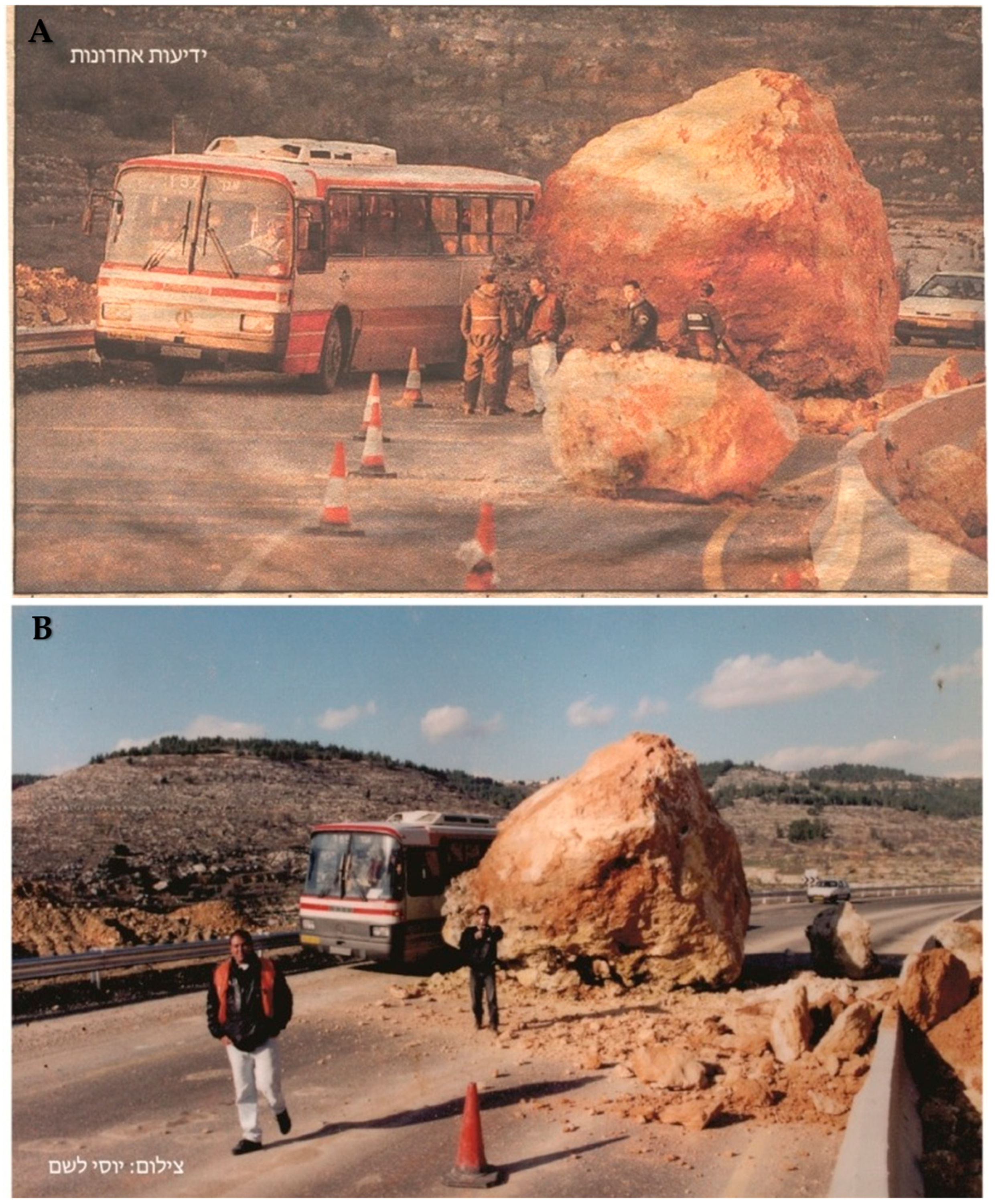
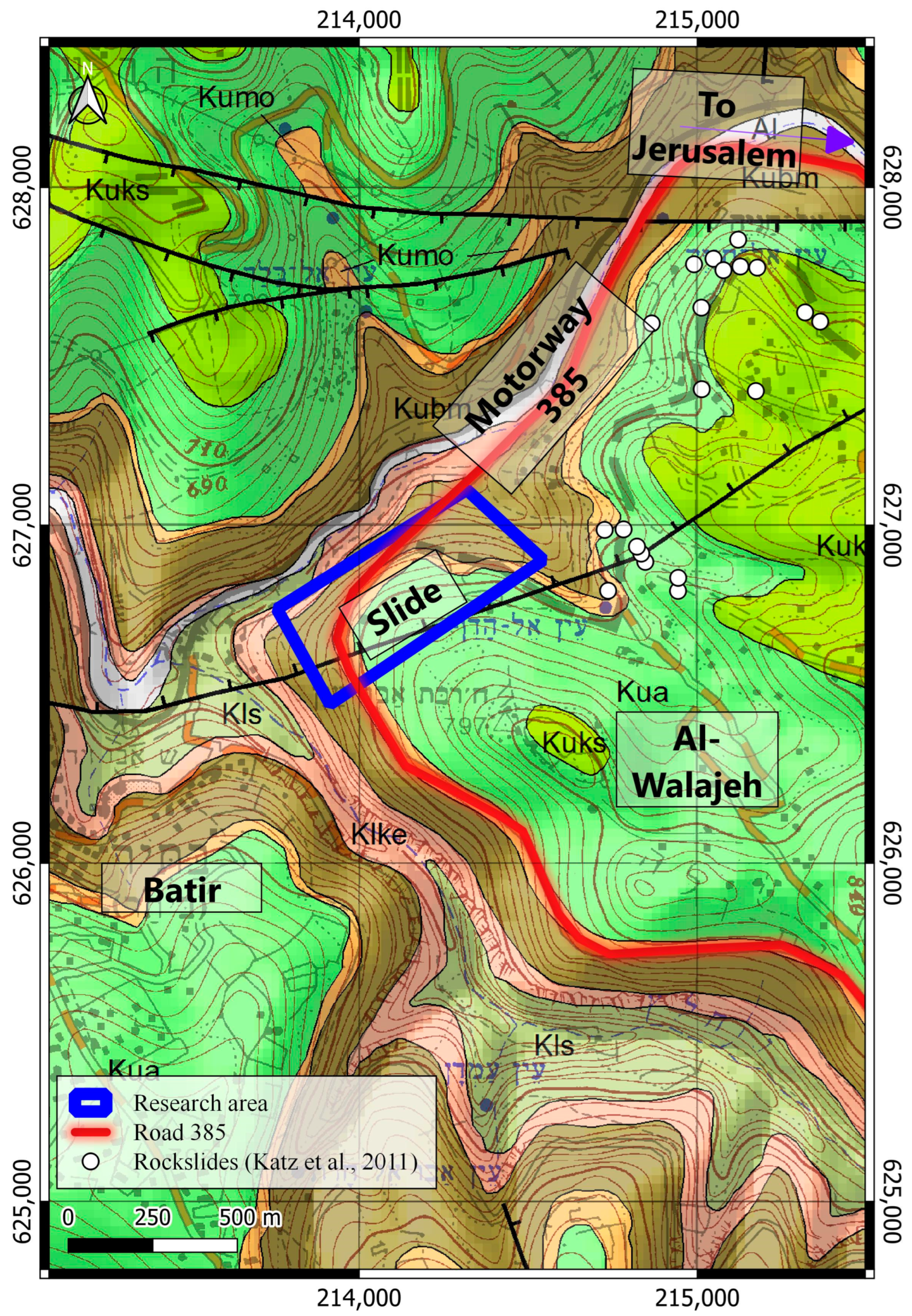

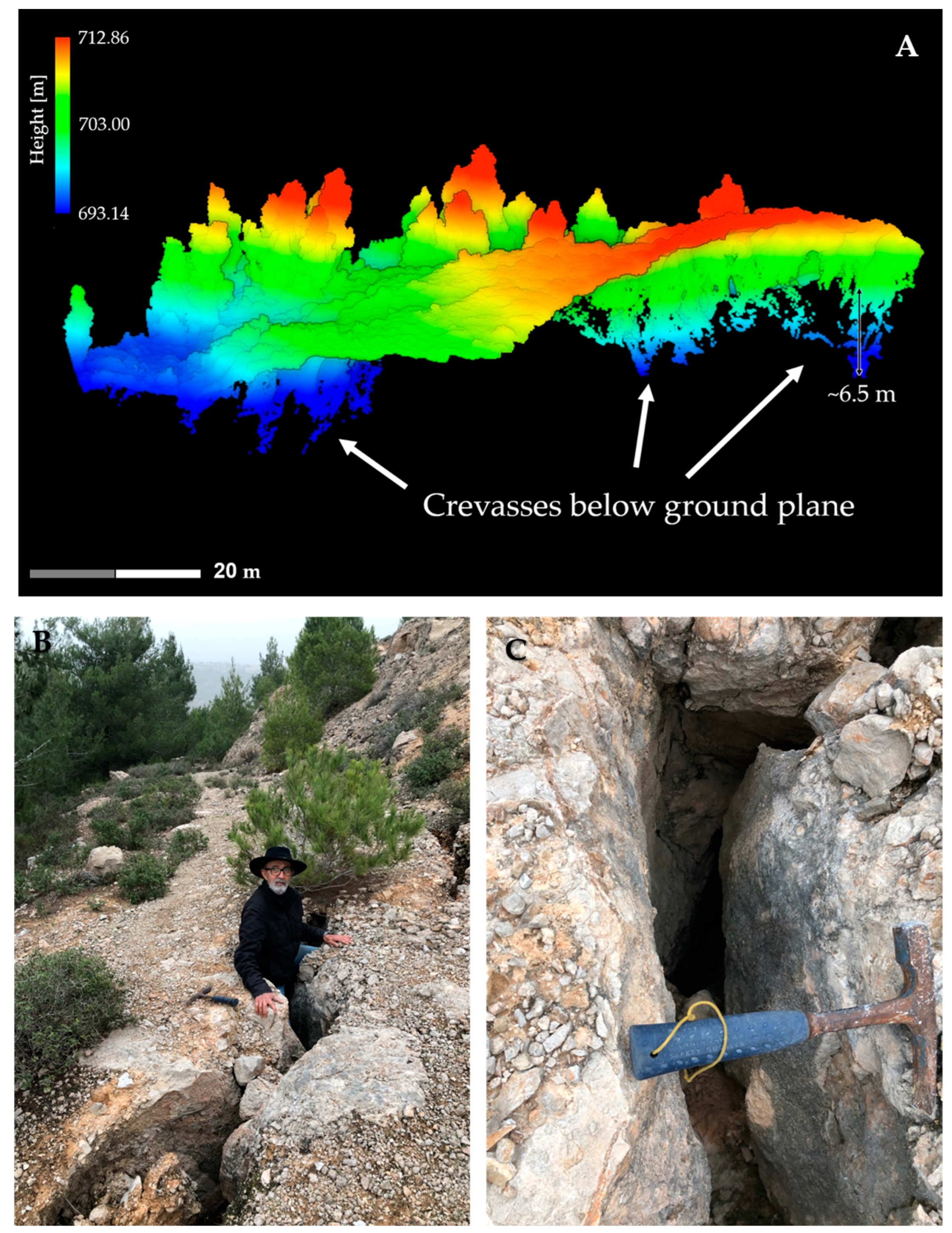
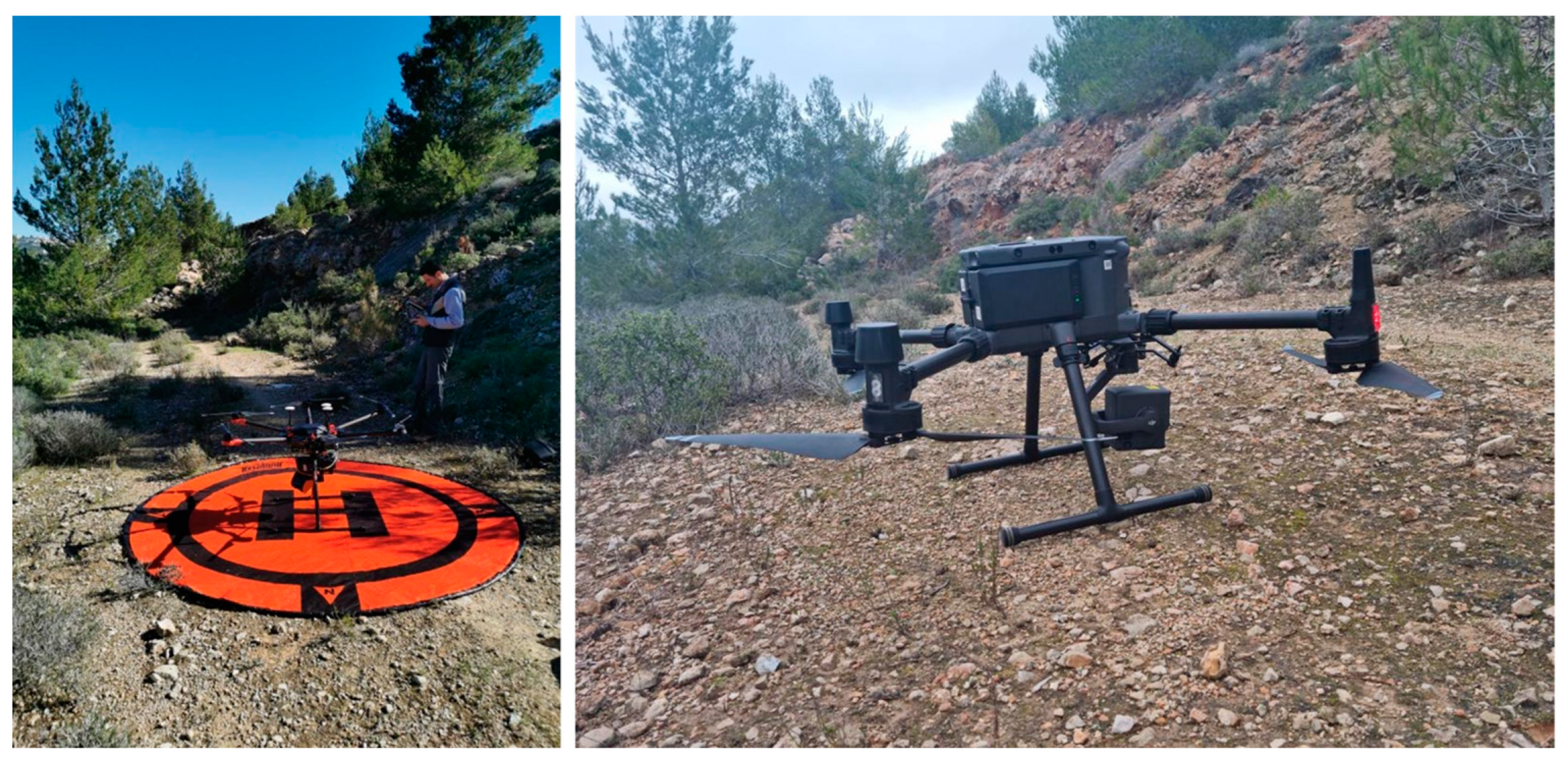
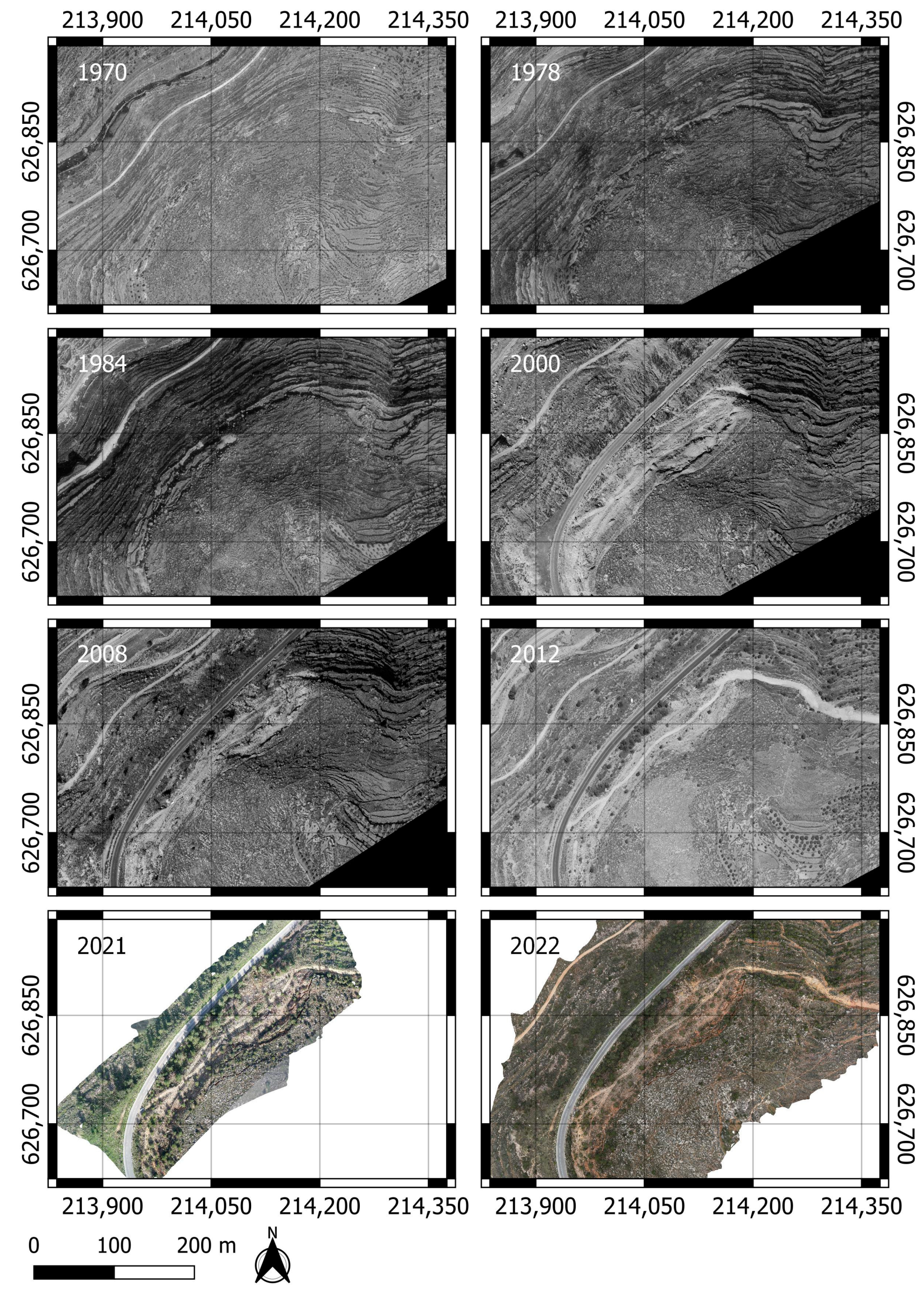
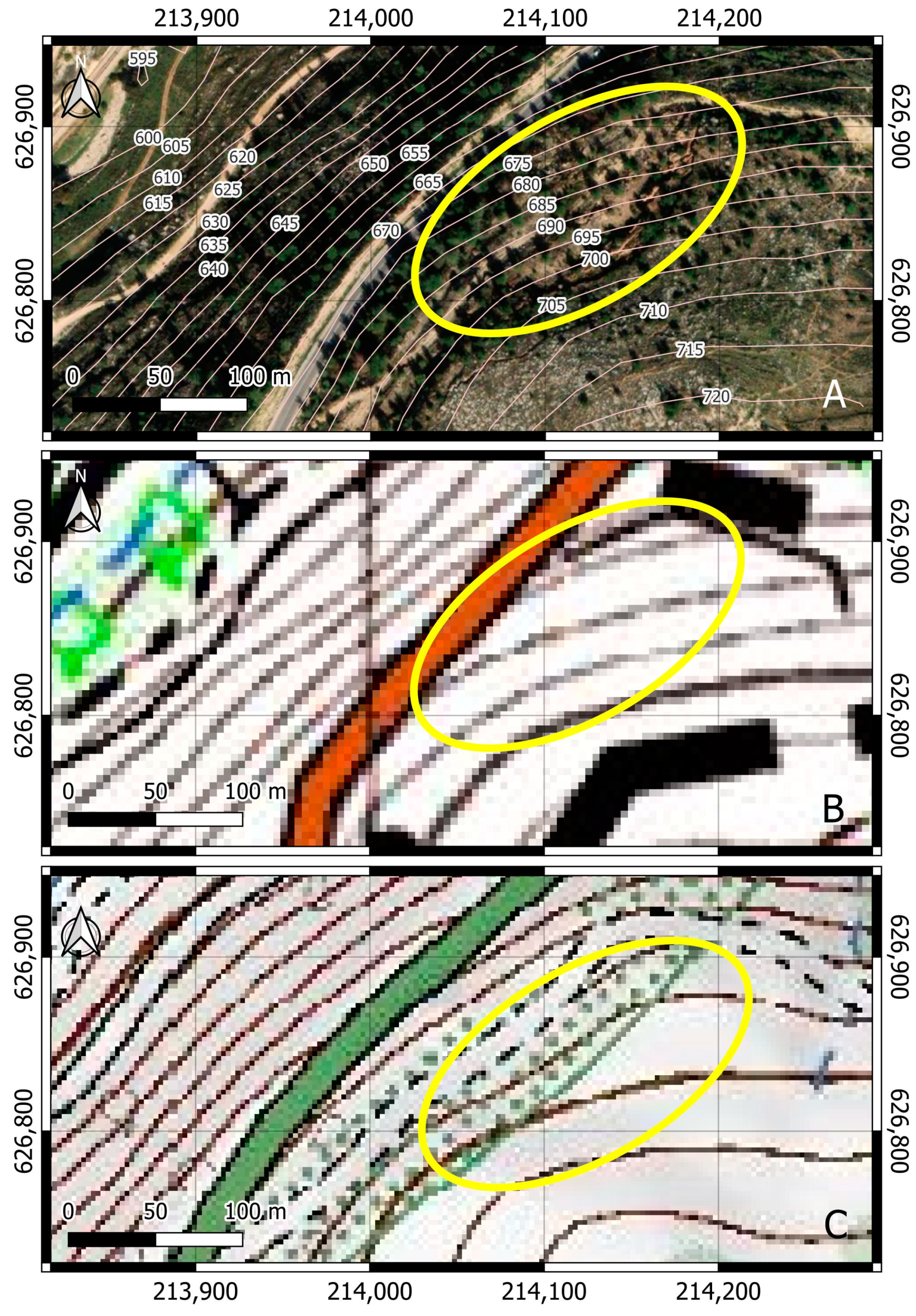

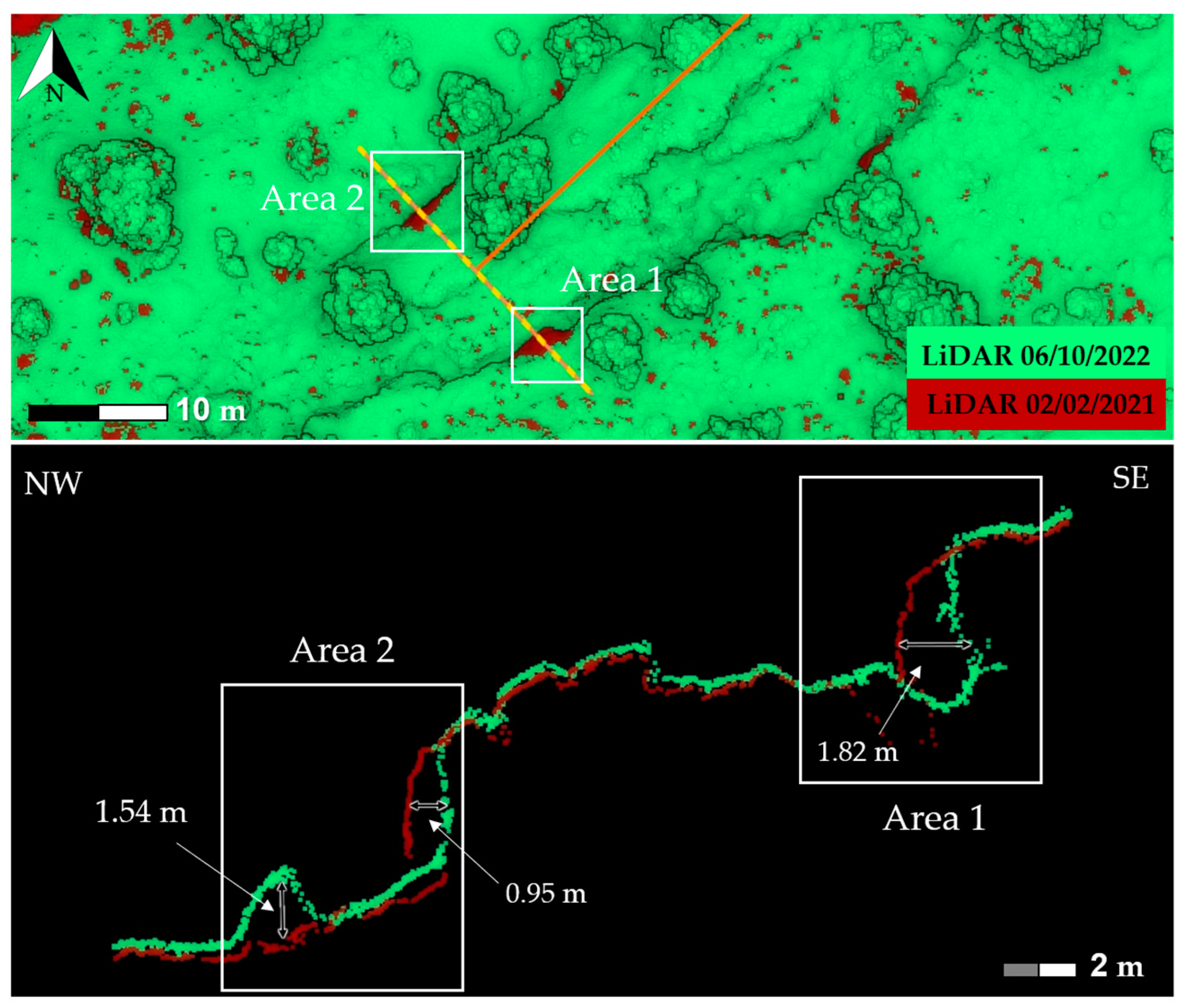
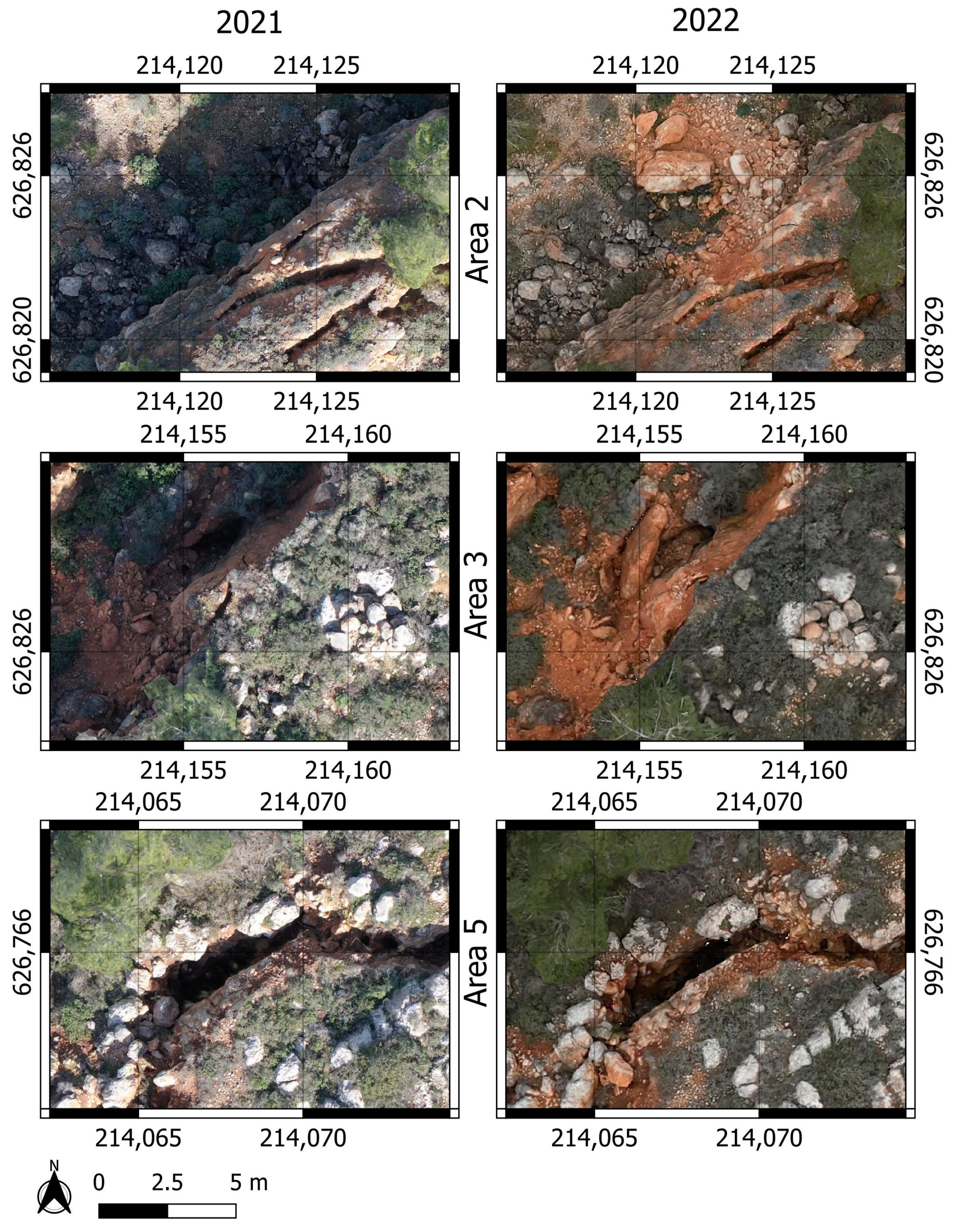
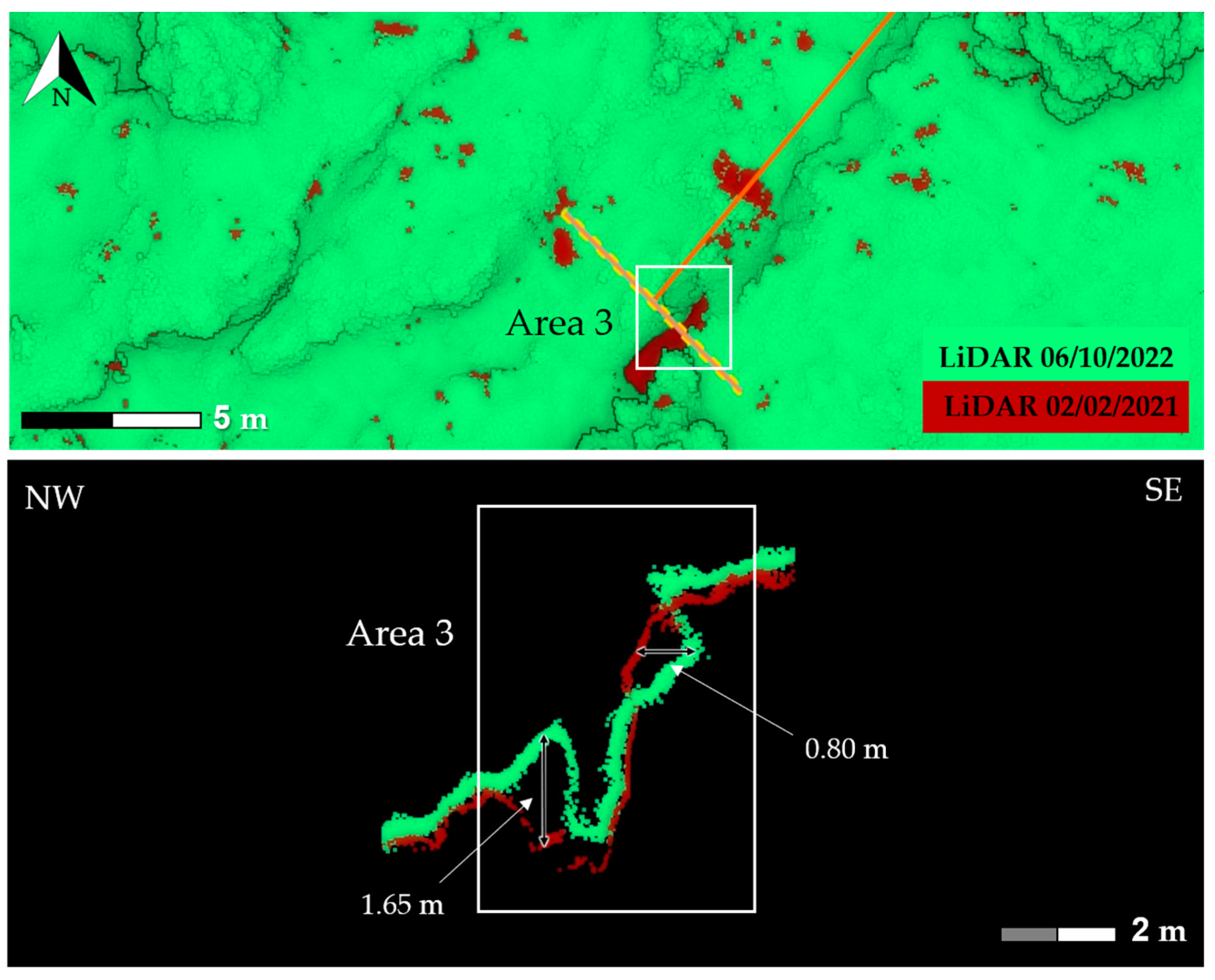
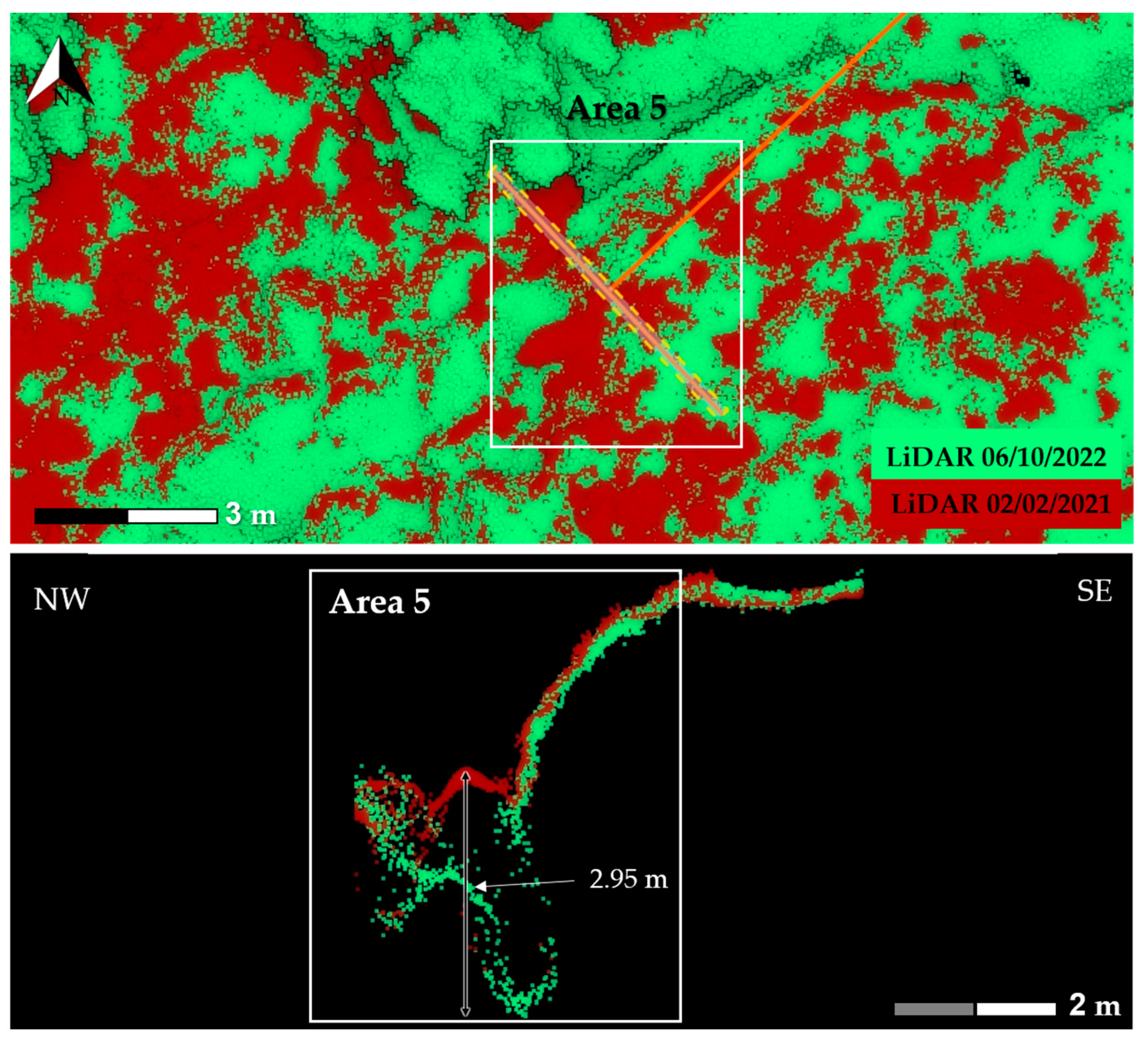
| Area\Offset [m] | 1 | 2 | 3 | 4 | 5 |
|---|---|---|---|---|---|
| Horizontal | 1.82 | 0.95 | 0.90 | - | - |
| Vertical | 1.91 | 1.54 | 1.65 | 1.61 | 2.95 |
Disclaimer/Publisher’s Note: The statements, opinions and data contained in all publications are solely those of the individual author(s) and contributor(s) and not of MDPI and/or the editor(s). MDPI and/or the editor(s) disclaim responsibility for any injury to people or property resulting from any ideas, methods, instructions or products referred to in the content. |
© 2024 by the authors. Licensee MDPI, Basel, Switzerland. This article is an open access article distributed under the terms and conditions of the Creative Commons Attribution (CC BY) license (https://creativecommons.org/licenses/by/4.0/).
Share and Cite
Darvasi, Y.; Laugomer, B.; Shicht, I.; Hall, J.K.; Ram, E.; Agnon, A. Drone-Borne LiDAR and Photogrammetry Together with Historical Data for Studying a Paleo-Landslide Reactivated by Road-Cutting and Barrier Construction outside Jerusalem. Geotechnics 2024, 4, 786-806. https://doi.org/10.3390/geotechnics4030041
Darvasi Y, Laugomer B, Shicht I, Hall JK, Ram E, Agnon A. Drone-Borne LiDAR and Photogrammetry Together with Historical Data for Studying a Paleo-Landslide Reactivated by Road-Cutting and Barrier Construction outside Jerusalem. Geotechnics. 2024; 4(3):786-806. https://doi.org/10.3390/geotechnics4030041
Chicago/Turabian StyleDarvasi, Yaniv, Ben Laugomer, Ido Shicht, John K. Hall, Eli Ram, and Amotz Agnon. 2024. "Drone-Borne LiDAR and Photogrammetry Together with Historical Data for Studying a Paleo-Landslide Reactivated by Road-Cutting and Barrier Construction outside Jerusalem" Geotechnics 4, no. 3: 786-806. https://doi.org/10.3390/geotechnics4030041
APA StyleDarvasi, Y., Laugomer, B., Shicht, I., Hall, J. K., Ram, E., & Agnon, A. (2024). Drone-Borne LiDAR and Photogrammetry Together with Historical Data for Studying a Paleo-Landslide Reactivated by Road-Cutting and Barrier Construction outside Jerusalem. Geotechnics, 4(3), 786-806. https://doi.org/10.3390/geotechnics4030041








